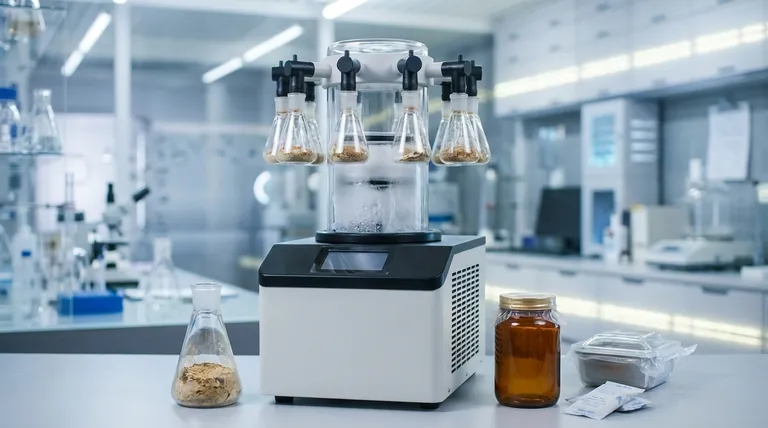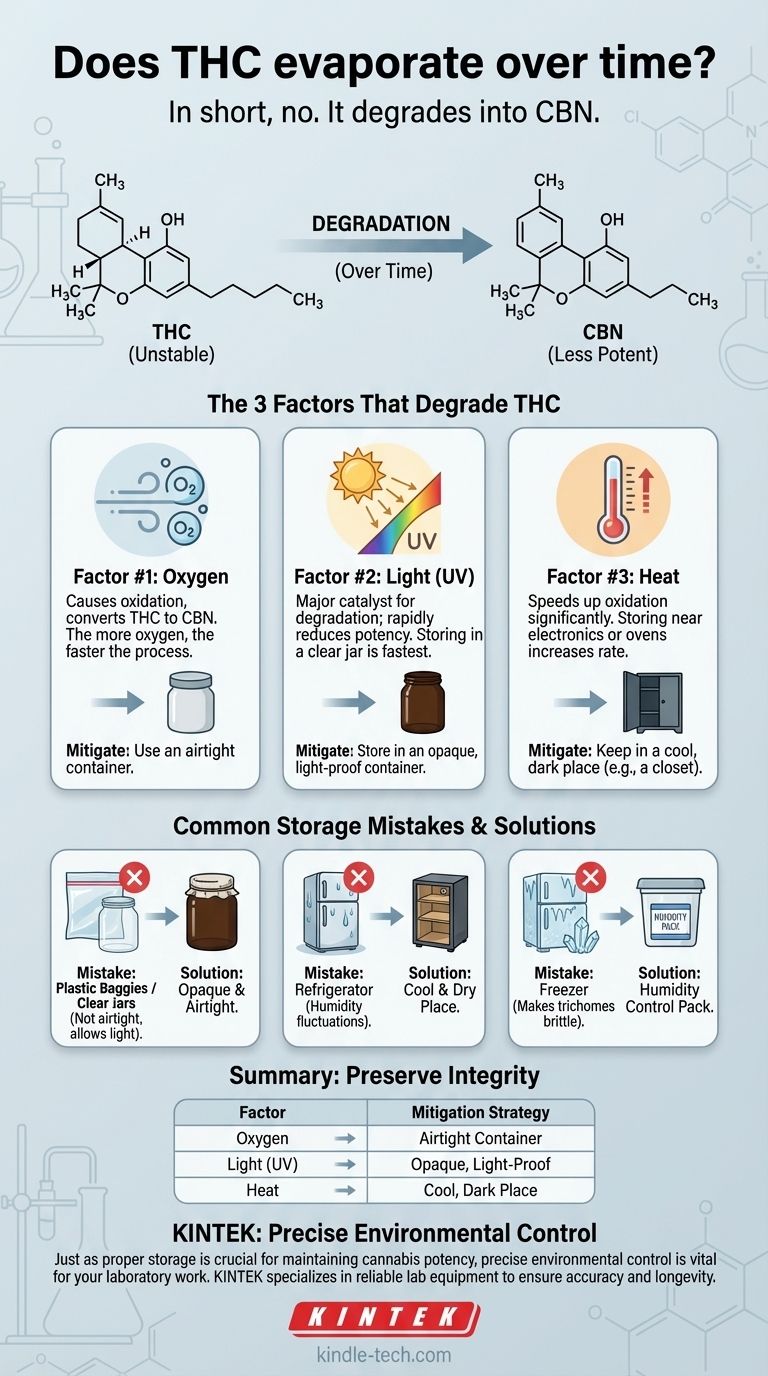In short, no. THC does not evaporate at room temperature in the way you might think of water turning into steam. However, it does degrade over time, breaking down into a different, less psychoactive compound. This process is what causes cannabis products to lose their potency, and it is accelerated by exposure to the environment.
The core issue isn't evaporation, but degradation. THC is an unstable molecule that changes its chemical structure when exposed to oxygen, light, and heat, converting into a cannabinoid called CBN and steadily losing its effectiveness.
Understanding THC Stability: Beyond Evaporation
The question of whether THC "evaporates" is a common one, but it stems from a slight misunderstanding of the chemical process at play. The real concern is the preservation of potency.
The Myth of Evaporation
For a substance to evaporate, it must reach its boiling point. The boiling point of THC is approximately 315°F (157°C).
This temperature is far higher than any normal storage condition. Therefore, THC molecules are not escaping your container as a gas; they are changing form within it.
The Real Culprit: Degradation into CBN
The primary way THC loses its psychoactive power is through oxidation. When a THC molecule is exposed to oxygen, especially with heat or UV light as a catalyst, it degrades into Cannabinol (CBN).
CBN has very mild psychoactive effects compared to THC and is known more for producing feelings of sedation or drowsiness. As your product ages, its ratio of THC-to-CBN shifts, altering its effects and reducing its primary potency.
The 3 Factors That Degrade THC
Think of THC like a freshly cut apple; exposure to the elements will cause it to "brown" or break down. Three key environmental factors are responsible for this degradation.
Factor #1: Oxygen
Oxidation is the principal chemical reaction that converts THC to CBN. The more oxygen your cannabis is exposed to, the faster this process occurs. This is why an airtight container is the single most important factor in preservation.
Factor #2: Light
Ultraviolet (UV) light is a powerful catalyst for THC degradation. Studies have shown that light exposure is arguably the single greatest factor in potency loss. Storing cannabis in a clear jar on a sunny windowsill is the fastest way to destroy its THC content.
Factor #3: Heat
Heat acts as an accelerator for the oxidation process. While cool temperatures slow down chemical reactions, higher temperatures speed them up significantly. Storing products near electronics, in a hot car, or above an oven will rapidly increase the rate of THC degradation.
Common Storage Mistakes That Accelerate Potency Loss
Understanding the science is one thing; applying it is another. Many common storage methods inadvertently harm the product.
Mistake #1: Using Plastic Baggies or Clear Jars
Plastic baggies are not airtight and do nothing to block light. Worse, their static charge can pull trichomes (the cannabinoid-rich crystals) off of flower. Clear glass jars, while airtight, allow full light exposure, promoting rapid degradation.
Mistake #2: Storing in the Refrigerator
While the cold seems like a good idea, refrigerators introduce a major problem: humidity fluctuations. Every time you open the door, you create condensation, which can increase the risk of mold and mildew on cannabis flower.
Mistake #3: The Freezer Fallacy
Freezing cannabis makes the delicate trichomes brittle and fragile. When handled, they can easily break off and fall to the bottom of the container, taking the majority of the product's THC with them. Thawing can also create condensation issues.
Making the Right Choice for Preservation
Your storage strategy should match your usage timeline. Protecting your product from oxygen, light, and heat is the universal goal.
- If your primary focus is long-term preservation (months to a year): Use an opaque, truly airtight container (like a Miron glass jar or a vacuum-sealed container) and store it in a cool, dark, and dry place like a closet or cabinet.
- If your primary focus is short-term storage (days to weeks): A simple amber or painted glass jar with an airtight lid kept in a drawer or cupboard is perfectly sufficient.
- If your primary focus is maximizing flavor and potency: Add a two-way humidity control pack (e.g., Boveda or Integra) inside your airtight, light-proof container to maintain the ideal moisture level, preserving both cannabinoids and terpenes.
Properly storing your cannabis product is the single most effective way to take control of its lifespan and ensure its quality is preserved.

Summary Table:
| Factor | Effect on THC | How to Mitigate |
|---|---|---|
| Oxygen | Causes oxidation, converting THC to less potent CBN. | Use an airtight container. |
| Light (UV) | Major catalyst for degradation; rapidly reduces potency. | Store in an opaque, light-proof container. |
| Heat | Speeds up the oxidation process significantly. | Keep in a cool, dark place like a cupboard or closet. |
Preserve the integrity of your materials with KINTEK. Just as proper storage is crucial for maintaining cannabis potency, precise environmental control is vital for your laboratory work. KINTEK specializes in reliable lab equipment and consumables designed to ensure accuracy and longevity in your research. Contact our experts today to find the perfect storage and processing solutions for your laboratory's unique needs.
Visual Guide

Related Products
- Benchtop Laboratory Freeze Dryer for Lab Use
- Benchtop Laboratory Vacuum Freeze Dryer
- Laboratory Sterilizer Lab Autoclave Pulse Vacuum Lifting Sterilizer
- Laboratory Sterilizer Lab Autoclave Vertical Pressure Steam Sterilizer for Liquid Crystal Display Automatic Type
- Laboratory Test Sieves and Sieving Machines
People Also Ask
- What types of liquid samples can be processed using a laboratory freeze dryer? Preserve Your Sensitive Materials
- What role do laboratory freeze dryers play in the food industry? Unlock Superior Food Preservation
- What is the primary function of a freeze dryer in a laboratory setting? Preserve Delicate Materials with Sublimation
- What role does freeze drying play in scientific research? Preserve Sample Integrity for Reliable Results
- What are the main steps involved in the freeze-drying process? A Guide to the 3 Key Stages



















